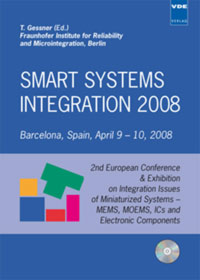From MEMS to Smart Systems Integration
Konferenz: Smart Systems Integration 2008 - 2nd European Conference & Exhibition on Integration Issues of Miniaturized Systems - MOMS, MOEMS, ICS and Electronic Components
09.04.2008 - 10.04.2008 in Barcelona, Spain
Tagungsband: Smart Systems Integration 2008
Seiten: 8Sprache: EnglischTyp: PDF
Persönliche VDE-Mitglieder erhalten auf diesen Artikel 10% Rabatt
Autoren:
Finkbeiner, Stefan (Robert Bosch GmbH, Corporate Sector Research and Advance Engineering, Dept. CR/ARY. Postfach 10 60 50, 70049 Stuttgart, Germany)
Inhalt:
The first MEMS devices have been introduced into the market only about 20 years ago, but during these past two decades we have witnessed a tremendous success story of MEMS for sensor applications. Up to now, the progress in MEMS technology was mainly driven by the automotive market. MEMS sensors have prevailed in automotive applications because they offered significant advantages compared to conventional solutions based on fine mechanical or ceramic technologies. First of all, the MEMS technology enables miniaturized, highly precise sensor elements at much lower cost compared to conventional solutions, especially for high volume production. Furthermore, the integration of the sensor element with an ASIC drastically reduces the number of connections and external components and thus allows a higher reliability of the sensors. Additionally, the implementation of self-test, accuracy check and calibration in the ASIC improves reliability and preciseness. Due to these advantages, a modern European car is equipped with more than 50 MEMS sensors on average. They are enablers for e.g. airbag systems, vehicle dynamic control or motor management systems with low emissions. In total, the world market for automotive MEMS sensors has a volume of 1.5 Billion Euros in 2008 and it will even grow over the next years. The most important representatives are pressure, flow, acceleration and angular rate sensors. These sensors are more or less commodity nowadays. In the near future these sensors will become smarter: Multi axis sensors and sensor units comprising different measurands will be developed and sensors will be combined with actuators in one common unit. The sensors will be integrated and evolve into smart systems due to additional intelligence and functionality. Examples out of the automotive world will be shown below. Besides the automotive market, MEMS actuators for inkjet heads and micromirrors have gained a quite impressive market volume. However, these applications are beyond the scope of this paper. In addition to these existing products, market studies (Fig. 1) predict promising new opportunities for microsystems and smart systems with very high growth rates: Consumer and medical applications offer high volumes for sensors, actuators and smart systems within the next years.


